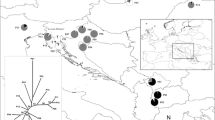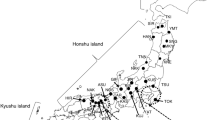Abstract
In Switzerland, chestnut forests cover about 27,100 ha, plus some 6800 ha of mixed stands. Due to environmental and historical reasons, most of these still existing forests are located in the Swiss Southern Alps, whereas in the northern parts of the country the chestnut cultivation and the related knowledge strongly regressed since the Little Ice Age period. Nevertheless, Switzerland still hosts valuable genetic resources of the sweet chestnut tree. The present genetic study bases on a nationwide inventory, identification and precise localisation of old and/or grafted chestnut trees for conservation purposes. The main objectives were: (1) to evaluate the genetic diversity and the genetic structure of Castanea sativa in Switzerland, and (2) to define a program of conservation including the proposal of a defined core collection. We genetically analysed a pre-selection of 962 accessions (out of 14,165 inventoried trees throughout Switzerland), profiling them with 24 microsatellites. We identified 675 different genotypes out of 962 accessions with a 29.8% of repetitiveness due to clonality. A structural analysis based on a Bayesian method allowed to identify two main clusters, one mostly related to the genetic group from southern Europe (Reconstructed Panmictic Population RPP1) and a second one (RPP2) which revealed to be independent and genetically different from other European groups of chestnut cultivars. The Swiss RPP2 represents a new genetic group, and consequently a complement to genetic resources of chestnut tree in Europe. Genetic analysis allowed defining a core collection of 46 genotypes, which should be used in priority for the Swiss conservation program.





Similar content being viewed by others
Data Accessibility Statement
A comprehensive DNA samples database is stored at the Institute Land Nature Environment (HES-SO University of applied sciences and arts western Switzerland).
References
Besnard G, Baradat P, Berville A (2001) Genetic relationships in the olive (Olea europaea L.) reflect multilocal selection of cultivars. Theor Appl Genet 102:251–258. https://doi.org/10.1007/s001220051642
Bradley RS, Hughes MK, Diaz HF (2003) Climate in medieval time. Science 302:404–405. https://doi.org/10.1126/science.1090372
Brändli UB (1998) Die häufigsten Waldbäume der Schweiz. Ergebnisse aus dem Landesforstinventar 1983–85: Verbreitung, Standort und Häufigkeit von 30 Baumarten, 2nd edn. Eidgenössische Forschungsanstalt für Wald, Schnee und Landschaft, Birmensdorf
Buck EJ, Hadonou M, James CJ, Blakesley D, Russell K (2003) Isolation and characterization of polymorphic microsatellites in European chestnut (Castanea sativa Mill.). Mol Ecol Notes 3:239–241. https://doi.org/10.1046/j.1471-8286.2003.00410.x
Buonincontri MP, Saracino A, Di Pasquale G (2015) The transition of chestnut (Castanea sativa Miller) from timber to fruit tree: Cultural and economic inferences in the Italian peninsula. Holocene 25(7):1111–1123. https://doi.org/10.1177/0959683615580198
Claros MG, Crespillo R, Aguilar ML, Canovas FM (2000) DNA fingerprinting and classification of geographically related genotypes of olive-tree (Olea europaea L.). Euphytica 116:131–142. https://doi.org/10.1023/A:1004011829274
Closuit R (1958) Le châtaingnier dans la vallée suisse du Rhône. Mitt Eidgenöss Anst Forstliche Vers 34(3):183–220
Conedera M, Barthold F, Torriani D, Pezzatti GB (2010) Drought sensitivity of Castanea sativa: case study of summer 2003 in the southern Alps. Acta Hortic 866:297–302
Conedera M, Krebs P, Tinner W, Pradella M, Torriani D (2004) The cultivation of Castanea sativa (Mill.) in Europe from its origin to its diffusion on a continental scale. Veg Hist Archaeobot 13:161–179. https://doi.org/10.1007/s00334-004-0038-7
Conedera M, Müller-Starck G, Fineschi S (1994) Genetic characterization of cultivated varieties of European Chestnut (Castanea sativa Mill.) in Southern Switzerland I Inventory of chestnut varieties: history and perspectives. In: Proceedings of the International Congress on Chestnut Spoleto Italy 20–23 October 1993, pp 299–302.
Conedera M, Stanga P, Lischer C, Stöckli V (2000) Competition and dynamics in abandoned chestnut orchards in southern Switzerland. Ecol Mediterr 26(1/2):101–112
Earl DA, Vonholdt BM (2012) STRUCTURE HARVESTER: a website and program for visualizing STRUCTURE output and implementing the Evanno method. Conserv Genet Resour 4:359–361. https://doi.org/10.1007/s12686-011-9548-7
Engler A (1901) Über Verbreitung Standortansprüche und Geschichte der Castanea vesca Gärtner mit besonderer Berücksichtigung der Schweiz. Ber Schweiz Bot Ges 9:23–62
Evanno G, Regnaut S, Goudet J (2005) Detecting the number of clusters of individuals using the software STRUCTURE: a simulation study. Mol Ecol 14:2611–2620. https://doi.org/10.1111/j.1365-294X.2005.02553.x
Forster B, Castellazzi T, Colombi L, Fürst E, Marazzi C, Meier F et al (2009) Die Edelkastaniengallwespe Dryocosmus kuriphilus (Yasumatsu) (Hymenoptera Cynipidae) tritt erstmals in der Südschweiz auf. Mitt Schweiz Entomol Ges 82:271–279. https://doi.org/10.5169/seals-402995
Furrer E (1958) Die Edelkastanie in der Innerschweiz. Mitt Eidgenöss Anstalt Forstl Vers 34(3):90–182
Furrer E (1972) Die früheste Kastanienkultur in der Innerschweiz und die heutigen Reste. Ber Schweiz Bot Ges 82(1):5–13
Gobbin D, Hohl L, Conza L, Jermini M, Gessler C, Conedera M (2007) Microsatellite-based characterization of the Castanea sativa cultivar heritage of southern Switzerland. Genome 50(12):1089–1103. https://doi.org/10.1139/G07-086
Heiniger U, Conedera M (1994) Chestnut forests and chestnut cultivation in Switzerland. In: Proceedings of the international chestnut conference West Virginia University College of Agriculture and Forestry Morgantown West Virginia July 10–14 1992, pp 175–178
Kampfer S, Lexer C, Glossl J, Steinkellner H (1998) Characterization of (GA)n microsatellite loci from Quercus robur. Hereditas 129:183–186. https://doi.org/10.1111/j.1601-5223.1998.00183.x
Krebs P, Koutsias N, Conedera M (2012) Modelling the eco-cultural niche of giant chestnut trees: new insights into land use history in southern Switzerland through distribution analysis of a living heritage. J Hist Geogr 38(4):372–386. https://doi.org/10.1016/j.jhg.2012.01.018
Krebs P, Pezzatti GB, Beffa G, Tinner W, Conedera M (2019) Revising the sweet chestnut (Castanea sativa Mill.) refugia history of the last glacial period with extended pollen and macrofossil evidence. Quat Sci Rev 206:111–128. https://doi.org/10.1016/j.quascirev.2019.01.002
Krebs P, Tinner W, Conedera M (2014) Del castagno e della castanicoltura nelle contrade insubriche: tentativo di una sintesi eco-storica. Arch Stor Ticin 155:5–37
Kim KW, Chung HK, Cho GT, Ma KH, Chandrabalan D, Gwag JG et al (2007) PowerCore: a program applying the advanced M strategy with a heuristic search for establishing core sets. Bioinformatics 23(16):2155–2162. https://doi.org/10.1093/bioinformatics/btm313
Lefort F, Douglas GC (1999) An efficient micro-method of DNA isolation from mature leaves of four hardwood tree species Acer Fraxinus Prunus and Quercus. Ann For Sci 56(3):259–263. https://doi.org/10.1051/forest:19990308
Marinoni D, Akkak A, Bounous G, Edwards KJ, Botta R (2003) Development and characterization of microsatellite markers in Castanea sativa (Mill). Mol Breed 11:127–136. https://doi.org/10.1023/A:1022456013692
Mattioni C, Martín MA, Pollegioni P, Cherubini M, Villani F (2013) Microsatellite markers reveal a strong geographical structure in European populations of Castanea sativa (Fagaceae): evidence for multiple glacial refugia. Am J Bot 100:951–961. https://doi.org/10.3732/ajb.1200194
Meirmans PG, Van Tienderen PH (2004) Genotype and genodive: two programs for the analysis of genetic diversity of asexual organisms. Mol Ecol Notes 4:792–794. https://doi.org/10.1111/j.1471-8286.2004.00770.x
Nei M (1978) Estimation of average heterozygosity and genetic distance from a small number of individuals. Genetics 89:583–590
Pasche S, Calmin G, Auderset G, Crovadore J, Pelleteret P, Mauch-Mani B et al (2016) Gnomoniopsis smithogilvyi prevalence in Castanea sativa shoots in Switzerland. Fungal Genet Biol 87:9–21. https://doi.org/10.1016/j.fgb.2016.01.002
Peakall R, Smouse PE (2006) GENALEX 6: genetic analysis in Excel Population genetic software for teaching and research. Mol Ecol Notes 6:288–295. https://doi.org/10.1111/j.1471-8286.2005.01155.x
Pereira-Lorenzo S, Costa R, Ramos-Cabrer AM, Ribeiro C, Serra da Silva C, Manzano G, Barreneche T (2010) Variation in grafted European chestnut and hybrids by microsatellites reveals two main origins in the Iberian Peninsula. Tree Genet Genomes 6:701–715. https://doi.org/10.1007/s11295-010-0285-y
Pereira-Lorenzo S, Lourenço Costa RM, Ramos-Cabrer AM, Ciordia-Ara M, Marques Ribeiro CA, Borges O, Barreneche T (2011) Chestnut cultivar diversification process in the Iberian Peninsula Canary Islands and Azores. Genome 54:301–315. https://doi.org/10.1139/g10-122
Pereira-Lorenzo S, Ramos Cabrer AM, Barreneche T, Mattioni C, Villani F, Díaz-Hernández MB et al (2017) Database of European chestnut cultivars and definition of a core collection using simple sequence repeats. Tree Genet Genomes 13:114. https://doi.org/10.1007/s11295-017-1197-x
Pereira-Lorenzo S, Ramos-Cabrer AM, Barreneche T, Mattioni C, Villani F, Díaz-Hernández MB et al (2019) Instant domestication process of European chestnut cultivars. Ann Appl Biol 174(1):74–85. https://doi.org/10.1111/aab.12474
Perrier X, Flori A, Bonnot F (2003) Data analysis methods. In: Hamon P, Seguin M, Perrier X, Glaszmann JC (eds) Genetic diversity of cultivated tropical plants science. Enfield, Science Publishers, Montpellier, pp 43–76
Perrier X, Jacquemoud-Collet JP (2006) DARwin software. Retrieved from https://darwin.cirad.fr/
Pitte JR (1986) Terre de castanides Hommes et paysages du châtaigniers de l’antiquité à nos jours. Fayard, Paris
Porras-Hurtado L, Ruiz Y, Santos C, Phillips C, Carracedo Á, Lareu MV (2013) An overview of STRUCTURE: applications, parameter settings, and supporting software. Front Genet 4:98. https://doi.org/10.3389/fgene.2013.00098
Pritchard JK, Stephens M, Donnelly P (2000) Inference of population structure using multilocus genotype data. Genetics 155(2):945–959
Rudow A, Bischofberger Y, Piattini P, Hatt S (2012) Handbook of sweet chestnut descriptors (Castanea sativa Mill.). Federal Office for Agriculture, Bern
Rudow A, Conedera M (2001) Blüte und Sortenerkennung bei der Edelkastanie (Castanea sativa Mill.) auf der Alpensüdseite der Schweiz. Bot Helv 111:1–23
Squatriti P (2013) Landscape and change in early medieval Italy: chestnuts economy and culture. University Press Cambridge, Cambridge
Steinkellner H, Fluch S, Turetschek E, Lexer C, Streiff R, Kremer A et al (1997) Identification and characterization of (GA/CT)(n)-microsatellite loci from Quercus petraea. Plant Mol Biol 33:1093–1096. https://doi.org/10.1023/A:1005736722794
Tanner H (1927) Die Verbreitung und wirtschaftliche Bedeutung der zahmen Kastanie im Kanton St Gallen. Jahrbuch St Gallischen Naturwissenschaftlichen Gesellschaft 63:27–48
van Hintum TJL, Brown AHD, Spillane C, Hodgkin T (2000) Core collections of plant genetic resources IPGRI. (Technical Bulletin No 3). International Plant Genetic Resources Institute, Rome, Italy
van Oosterhout C, Hutchinson WF, Wills DPM, Shipley P (2004) MICRO-CHECKER: software for identifying and correcting genotyping errors in microsatellite data. Mol Ecol Resour 4:535–538. https://doi.org/10.1111/j.1471-8286.2004.00684.x
Weir BS, Cockerham CC (1984) Estimating F-statistics for the analysis of population structure. Evolution 38:1358–1370. https://doi.org/10.2307/2408641
Acknowledgements
This study was funded by the Swiss Federal Office for Agriculture FOAG in the framework of the Swiss National Plan of Action for plant genetic resources for food and agriculture. We thank to the Spanish government for the funds under the contract AGL2013-48017-C2-2-R to compare allele ranges with Spanish samples.
Author information
Authors and Affiliations
Contributions
Designed research: SP-L, YB, TB, FL. Performed research: SP-L, YB, MC, PP, JC, RC, AR, SH, AMR-C, TB, FL. Contributed new reagents or analytical tools: SP-L, MC, AMR-C, HC, TB, FL. Analyzed data: SP-L, MC, RC, AMR-C, TB, FL. Wrote the paper: SP-L, YB, MC, PP, AR, SH, AMR-C, TB, FL.
Corresponding author
Additional information
Communicated by Daniel Sanchez Mata.
Publisher's Note
Springer Nature remains neutral with regard to jurisdictional claims in published maps and institutional affiliations.
This article belongs to the Topical Collection: Forest and plantation biodiversity.
Electronic supplementary material
Below is the link to the electronic supplementary material.
Rights and permissions
About this article
Cite this article
Pereira-Lorenzo, S., Bischofberger, Y., Conedera, M. et al. Reservoir of the European chestnut diversity in Switzerland. Biodivers Conserv 29, 2217–2234 (2020). https://doi.org/10.1007/s10531-020-01970-2
Received:
Revised:
Accepted:
Published:
Issue Date:
DOI: https://doi.org/10.1007/s10531-020-01970-2




